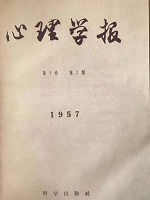|
|
PRELIMINARY STUDIES ON PREDICTION OF MOTION
TSAO JIH-CHANG, CHING CHI-CHENG, AND LIN CHUNG-HSIEN Institute of Psychology, Academia Sinica
1957, 1 (2):
40-54.
Forty-seven adults and thirty-six children were used as Ss in an experiment in prediction of motion. A visual stimulus, after moving at constant speed in a linear course for 40 cm., passed out of sight and continued its. movement behind a shutter. The Ss were required to make motor reactions with the right hand when the stimulus reached a target at a distance of 18 cm. from the point of concealment.Structure of the movement field, methods of prediction, practice, knowledge of results, transfer of training and other conditions were investigated as to their effects on the prediction. The results show:(1)Variation of the structure field by adding vertical lines at equal intervals on the path of movement exercised little or no influence on the Ss' prediction scores.(2)Oral counting done by the Ss showed no iniluence on the prediction scores.(3)Predictions accompanied with movements made by the Ss with the left hand along a metal bar in accordance with the visual moving stimulus showed positive results, effecting an increase in the accuracy of prediction up to 40 per cent. (4)Demarkating intervals on the movement path accompanied by the Ss' oral counting during the prediction exercised positive influence, raising precision scores of 50 per cent or more.(5)Knowledge of results as a kind of incentive promoted the Ss' predictions.(6)Among children Ss, the accuracy of prediction manifested a tendency to increase with age, the 11-12-year-olds reaching almost the level of adults.(7)In the preliminary stages of prediction, practice had no marked effect, only after a certain number of trials (after 50 trials) improvements occurred.(8)Practice made with the prediction of one speed had an effect of positive transfer to another similar speed. A stationary stimulus in the form of a coloured light exposed simultaneously with the practice speed had no influence on the amount of transfer, but influenced the directions of erroneous responses. It seems that the Ss confused the tested speeds with the practiced speeds, thus affecting unilateral deviation in the direction of over-estimation or under-estimation.(9)When the Ss were being informed about the order among the different speeds, marked positive transfer was observed. This is especially the case if the tested speeds were of considerable difference with the practiced speeds.This investigation being a preliminary one was made with rather small groups of Ss and a limited number of trials, the results, with particular exceptions, were not statistically treated. The results indicated only a general trend and further study is required.
Related Articles |
Metrics
|




